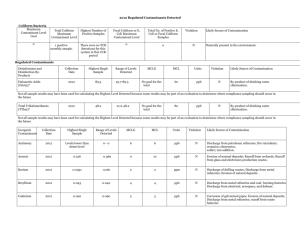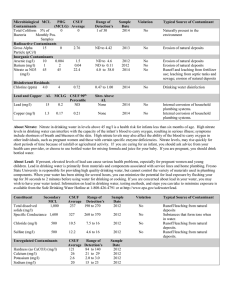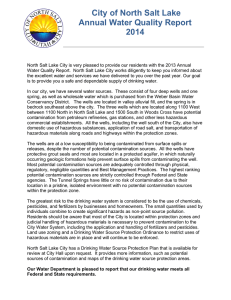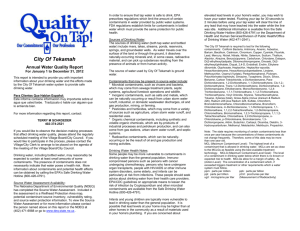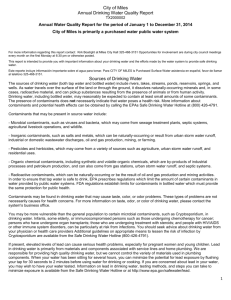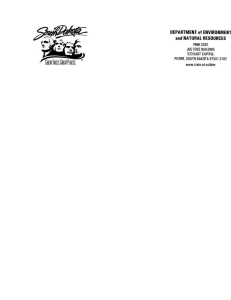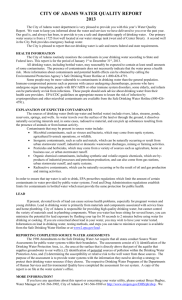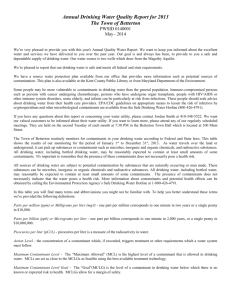water quality report year 2007
advertisement
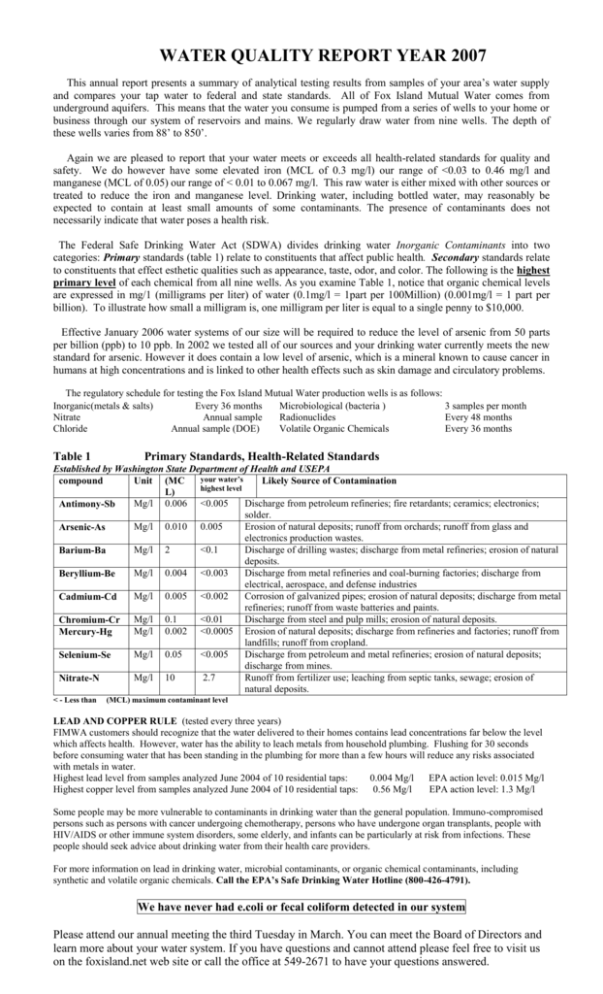
WATER QUALITY REPORT YEAR 2007 This annual report presents a summary of analytical testing results from samples of your area’s water supply and compares your tap water to federal and state standards. All of Fox Island Mutual Water comes from underground aquifers. This means that the water you consume is pumped from a series of wells to your home or business through our system of reservoirs and mains. We regularly draw water from nine wells. The depth of these wells varies from 88’ to 850’. Again we are pleased to report that your water meets or exceeds all health-related standards for quality and safety. We do however have some elevated iron (MCL of 0.3 mg/l) our range of <0.03 to 0.46 mg/l and manganese (MCL of 0.05) our range of < 0.01 to 0.067 mg/l. This raw water is either mixed with other sources or treated to reduce the iron and manganese level. Drinking water, including bottled water, may reasonably be expected to contain at least small amounts of some contaminants. The presence of contaminants does not necessarily indicate that water poses a health risk. The Federal Safe Drinking Water Act (SDWA) divides drinking water Inorganic Contaminants into two categories: Primary standards (table 1) relate to constituents that affect public health. Secondary standards relate to constituents that effect esthetic qualities such as appearance, taste, odor, and color. The following is the highest primary level of each chemical from all nine wells. As you examine Table 1, notice that organic chemical levels are expressed in mg/1 (milligrams per liter) of water (0.1mg/l = 1part per 100Million) (0.001mg/l = 1 part per billion). To illustrate how small a milligram is, one milligram per liter is equal to a single penny to $10,000. Effective January 2006 water systems of our size will be required to reduce the level of arsenic from 50 parts per billion (ppb) to 10 ppb. In 2002 we tested all of our sources and your drinking water currently meets the new standard for arsenic. However it does contain a low level of arsenic, which is a mineral known to cause cancer in humans at high concentrations and is linked to other health effects such as skin damage and circulatory problems. The regulatory schedule for testing the Fox Island Mutual Water production wells is as follows: Inorganic(metals & salts) Every 36 months Microbiological (bacteria ) 3 samples per month Nitrate Annual sample Radionuclides Every 48 months Chloride Annual sample (DOE) Volatile Organic Chemicals Every 36 months Table 1 Primary Standards, Health-Related Standards Established by Washington State Department of Health and USEPA your water’s compound Unit (MC Likely Source of Contamination highest level L) Mg/l 0.006 <0.005 Discharge from petroleum refineries; fire retardants; ceramics; electronics; Antimony-Sb solder. Mg/l 0.010 0.005 Erosion of natural deposits; runoff from orchards; runoff from glass and Arsenic-As electronics production wastes. Mg/l 2 <0.1 Discharge of drilling wastes; discharge from metal refineries; erosion of natural Barium-Ba deposits. Mg/l 0.004 <0.003 Discharge from metal refineries and coal-burning factories; discharge from Beryllium-Be electrical, aerospace, and defense industries Mg/l 0.005 <0.002 Corrosion of galvanized pipes; erosion of natural deposits; discharge from metal Cadmium-Cd refineries; runoff from waste batteries and paints. <0.01 Discharge from steel and pulp mills; erosion of natural deposits. Chromium-Cr Mg/l 0.1 Mg/l 0.002 <0.0005 Erosion of natural deposits; discharge from refineries and factories; runoff from Mercury-Hg landfills; runoff from cropland. Mg/l 0.05 <0.005 Discharge from petroleum and metal refineries; erosion of natural deposits; Selenium-Se discharge from mines. Mg/l 10 2.7 Runoff from fertilizer use; leaching from septic tanks, sewage; erosion of Nitrate-N natural deposits. < - Less than (MCL) maximum contaminant level LEAD AND COPPER RULE (tested every three years) FIMWA customers should recognize that the water delivered to their homes contains lead concentrations far below the level which affects health. However, water has the ability to leach metals from household plumbing. Flushing for 30 seconds before consuming water that has been standing in the plumbing for more than a few hours will reduce any risks associated with metals in water. Highest lead level from samples analyzed June 2004 of 10 residential taps: 0.004 Mg/l EPA action level: 0.015 Mg/l Highest copper level from samples analyzed June 2004 of 10 residential taps: 0.56 Mg/l EPA action level: 1.3 Mg/l Some people may be more vulnerable to contaminants in drinking water than the general population. Immuno-compromised persons such as persons with cancer undergoing chemotherapy, persons who have undergone organ transplants, people with HIV/AIDS or other immune system disorders, some elderly, and infants can be particularly at risk from infections. These people should seek advice about drinking water from their health care providers. For more information on lead in drinking water, microbial contaminants, or organic chemical contaminants, including synthetic and volatile organic chemicals. Call the EPA’s Safe Drinking Water Hotline (800-426-4791). We have never had e.coli or fecal coliform detected in our system Please attend our annual meeting the third Tuesday in March. You can meet the Board of Directors and learn more about your water system. If you have questions and cannot attend please feel free to visit us on the foxisland.net web site or call the office at 549-2671 to have your questions answered.
